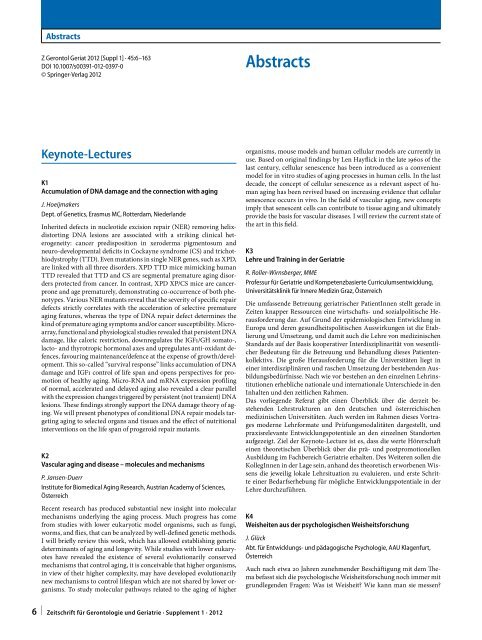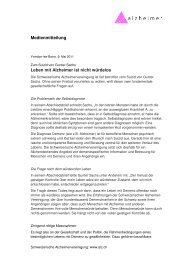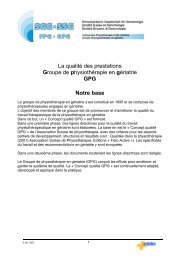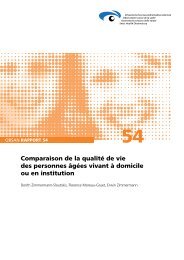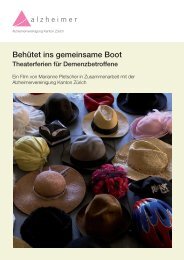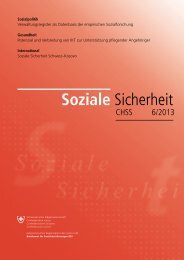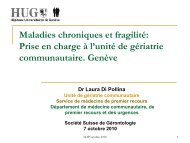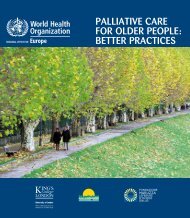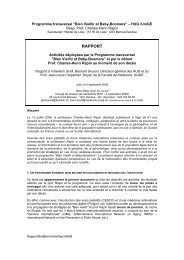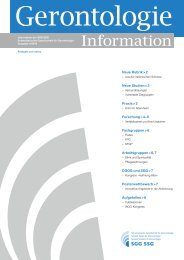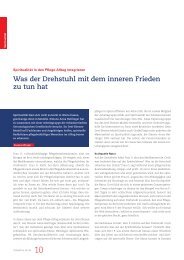Gerontologie+ Geriatrie - SGG-SSG
Gerontologie+ Geriatrie - SGG-SSG
Gerontologie+ Geriatrie - SGG-SSG
Sie wollen auch ein ePaper? Erhöhen Sie die Reichweite Ihrer Titel.
YUMPU macht aus Druck-PDFs automatisch weboptimierte ePaper, die Google liebt.
Abstracts<br />
Z Gerontol Geriat 2012 [Suppl 1] · 45:6–163<br />
DOI 10.1007/s00391-012-0397-0<br />
© Springer-Verlag 2012<br />
Abstracts<br />
Keynote-Lectures<br />
K1<br />
Accumulation of DNA damage and the connection with aging<br />
J. Hoeijmakers<br />
Dept. of Genetics, Erasmus MC, Rotterdam, Niederlande<br />
Inherited defects in nucleotide excision repair (NER) removing helixdistorting<br />
DNA lesions are associated with a striking clinical heterogeneity:<br />
cancer predisposition in xeroderma pigmentosum and<br />
neuro-developmental deficits in Cockayne syndrome (CS) and trichothiodystrophy<br />
(TTD). Even mutations in single NER genes, such as XPD,<br />
are linked with all three disorders. XPD TTD mice mimicking human<br />
TTD revealed that TTD and CS are segmental premature aging disorders<br />
protected from cancer. In contrast, XPD XP/CS mice are cancerprone<br />
and age prematurely, demonstrating co-occurrence of both phenotypes.<br />
Various NER mutants reveal that the severity of specific repair<br />
defects strictly correlates with the acceleration of selective premature<br />
aging features, whereas the type of DNA repair defect determines the<br />
kind of premature aging symptoms and/or cancer susceptibility. Microarray,<br />
functional and physiological studies revealed that persistent DNA<br />
damage, like caloric restriction, downregulates the IGF1/GH somato-,<br />
lacto- and thyrotropic hormonal axes and upregulates anti-oxidant defences,<br />
favouring maintenance/defence at the expense of growth/development.<br />
This so-called “survival response” links accumulation of DNA<br />
damage and IGF1 control of life span and opens perspectives for promotion<br />
of healthy aging. Micro-RNA and mRNA expression profiling<br />
of normal, accelerated and delayed aging also revealed a clear parallel<br />
with the expression changes triggered by persistent (not transient) DNA<br />
lesions. These findings strongly support the DNA damage theory of aging.<br />
We will present phenotypes of conditional DNA repair models targeting<br />
aging to selected organs and tissues and the effect of nutritional<br />
interventions on the life span of progeroid repair mutants.<br />
K2<br />
Vascular aging and disease – molecules and mechanisms<br />
P. Jansen-Duerr<br />
Institute for Biomedical Aging Research, Austrian Academy of Sciences,<br />
Österreich<br />
Recent research has produced substantial new insight into molecular<br />
mechanisms underlying the aging process. Much progress has come<br />
from studies with lower eukaryotic model organisms, such as fungi,<br />
worms, and flies, that can be analyzed by well-defined genetic methods.<br />
I will briefly review this work, which has allowed establishing genetic<br />
determinants of aging and longevity. While studies with lower eukaryotes<br />
have revealed the existence of several evolutionarily conserved<br />
mechanisms that control aging, it is conceivable that higher organisms,<br />
in view of their higher complexity, may have developed evolutionarily<br />
new mechanisms to control lifespan which are not shared by lower organisms.<br />
To study molecular pathways related to the aging of higher<br />
organisms, mouse models and human cellular models are currently in<br />
use. Based on original findings by Len Hayflick in the late 1960s of the<br />
last century, cellular senescence has been introduced as a convenient<br />
model for in vitro studies of aging processes in human cells. In the last<br />
decade, the concept of cellular senescence as a relevant aspect of human<br />
aging has been revived based on increasing evidence that cellular<br />
senescence occurs in vivo. In the field of vascular aging, new concepts<br />
imply that senescent cells can contribute to tissue aging and ultimately<br />
provide the basis for vascular diseases. I will review the current state of<br />
the art in this field.<br />
K3<br />
Lehre und Training in der <strong>Geriatrie</strong><br />
R. Roller-Wirnsberger, MME<br />
Professur für <strong>Geriatrie</strong> und Kompetenzbasierte Curriculumsentwicklung,<br />
Universitätsklinik für Innere Medizin Graz, Österreich<br />
Die umfassende Betreuung geriatrischer PatientInnen stellt gerade in<br />
Zeiten knapper Ressourcen eine wirtschafts- und sozialpolitische Herausforderung<br />
dar. Auf Grund der epidemiologischen Entwicklung in<br />
Europa und deren gesundheitspolitischen Auswirkungen ist die Etablierung<br />
und Umsetzung, und damit auch die Lehre von medizinischen<br />
Standards auf der Basis kooperativer Interdisziplinarität von wesentlicher<br />
Bedeutung für die Betreuung und Behandlung dieses Patientenkollektivs.<br />
Die große Herausforderung für die Universitäten liegt in<br />
einer interdisziplinären und raschen Umsetzung der bestehenden Ausbildungsbedürfnisse.<br />
Nach wie vor bestehen an den einzelnen Lehrinstitutionen<br />
erhebliche nationale und internationale Unterschiede in den<br />
Inhalten und den zeitlichen Rahmen.<br />
Das vorliegende Referat gibt einen Überblick über die derzeit bestehenden<br />
Lehrstrukturen an den deutschen und österreichischen<br />
medizinischen Universitäten. Auch werden im Rahmen dieses Vortrages<br />
moderne Lehrformate und Prüfungsmodalitäten dargestellt, und<br />
praxisrelevante Entwicklungspotentiale an den einzelnen Standorten<br />
aufgezeigt. Ziel der Keynote-Lecture ist es, dass die werte Hörerschaft<br />
einen theoretischen Überblick über die prä- und postpromotionellen<br />
Ausbildung im Fachbereich <strong>Geriatrie</strong> erhalten. Des Weiteren sollen die<br />
KollegInnen in der Lage sein, anhand des theoretisch erworbenen Wissens<br />
die jeweilig lokale Lehrsituation zu evaluieren, und erste Schritte<br />
einer Bedarfserhebung für mögliche Entwicklungspotentiale in der<br />
Lehre durchzuführen.<br />
K4<br />
Weisheiten aus der psychologischen Weisheitsforschung<br />
J. Glück<br />
Abt. für Entwicklungs- und pädagogische Psychologie, AAU Klagenfurt,<br />
Österreich<br />
Auch nach etwa 20 Jahren zunehmender Beschäftigung mit dem Thema<br />
befasst sich die psychologische Weisheitsforschung noch immer mit<br />
grundlegenden Fragen: Was ist Weisheit? Wie kann man sie messen?<br />
6 | Zeitschrift für Gerontologie und <strong>Geriatrie</strong> · Supplement 1 · 2012


